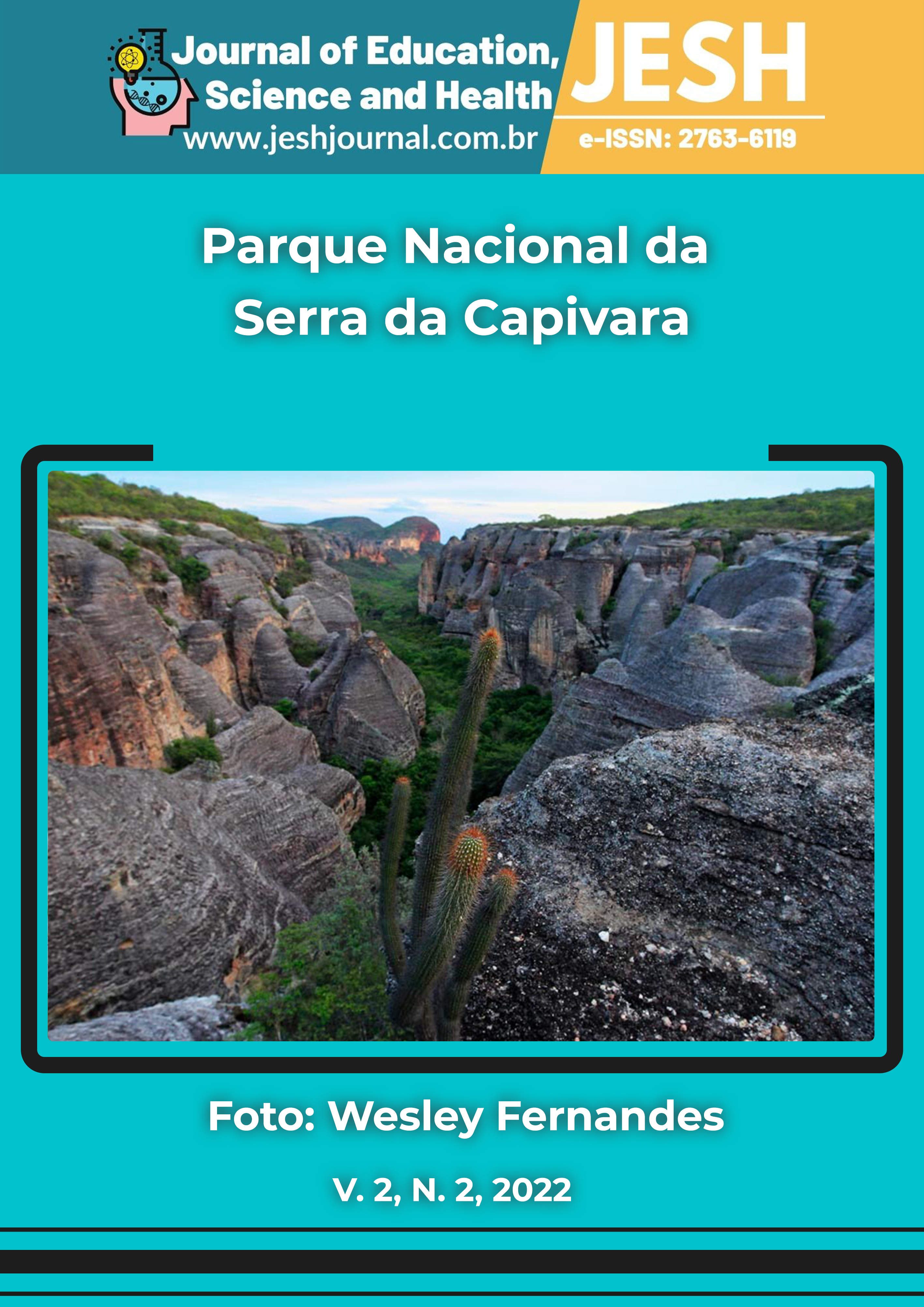ANÁLISIS DE LA INTERACCIÓN DEL CONTAMINANTE METILMERCURIO CON LA HEMOGLOBINA DEL PESCADO MATRINXÃ Brycon cephalus(GÜNTHER, 1869)
Analysis of the interaction of the contaminant methylmercury with hemoglobin from the fish matrinxã Brycon cephalus (Günther, 1869)
DOI:
10.52832/jesh.v2i2.132Palabras clave:
Contaminantes, Mercúrio, Peixes, ToxicidadeResumen
El daño ambiental debido a un entorno desequilibrado provoca problemas que a menudo sonirreversibles para la biota. El aumento de lapoblacióndesencadenael aumento de laproducción y el consumo industrial, y muchasveces tanto las industrias como los particulares no disponencorrectamente de sus residuos, provocando lacontaminaciónenel aire, elsuelo y elagua. Enelagua, los contaminantes puedensufrirelproceso de bioacumulación y bimagnificación, llegando a los humanos a través del consumo de pescado, por ejemplo. El metilmercurio es una forma tóxica delmercurio, siendo altamente contaminante y contaminante en contacto conlos seres vivos. El objetivo de esta investigaciónfue verificar elpatrón de interacción entre elmetilmercurio y la hemoglobina enel pez Brycon cephalus mediante acoplamiento molecular. La energía libre de uniónobtenida para elcomplejo hemoglobina-metilmercuriofue de -2,0 kcal/mol. Seis aminoácidos de la hemoglobina participaronenlaunión al metilmercurio, a saber: valina, serina, leucina, arginina y fenilalanina. El acoplamiento molecular indicóla tendencia delmercurio a unirse a la hemoglobina Brycon cephalus, lo que puededañarel metabolismo. Por lo tanto, deberíanocurrirnuevos experimentos complementarios (in vitro e in vivo) para evaluarelposibleefecto tóxico delmetilmercurioen esta especie.
Descargas
Métricas
Citas
Berman, H. M. (2000). The Protein Data Bank. Nucleic Acids Research, 28(1), 235–242. https://doi.org/10.1093/nar/28.1.235 DOI: https://doi.org/10.1093/nar/28.1.235
Bolton, E. E., Wang, Y., Thiessen, P. A., & Bryant, S. H. (2008). PubChem: Integrated Platform of Small Molecules and Biological Activities. Annual Reports in Computational Chemistry, 217–241. https://doi.org/10.1016/s1574-1400(08)00012-1 DOI: https://doi.org/10.1016/S1574-1400(08)00012-1
Chan, P. H. Y., Chan, M. H. M., Li, A. M., Cheung, R. C. K., Yu, X. T., & Lam, H. S. (2018). Methylmercury levels in commonly consumed fish and methylmercury exposure of children and women of childbearing age in Hong Kong, a high fish consumption community. Environmental Research, 166, 418–426. https://doi.org/10.1016/j.envres.2018.06.033 DOI: https://doi.org/10.1016/j.envres.2018.06.033
Donald, D. B., Wissel, B., & Anas, M. U. M. (2015). Species-specific Mercury bioaccumulation in a diverse fish community. Environmental Toxicology and Chemistry, 34(12), 2846–2855.https://doi.org/10.1002/etc.3130 DOI: https://doi.org/10.1002/etc.3130
Gimenes, T. C., Penteado, J. O., dos Santos, M., & da Silva Júnior, F. M. R. (2021). Methylmercury in Fish from the Amazon Regiona Review Focusedon Eating Habits. Water, Air, &SoilPollution, 232(5). https://doi.org/10.1007/s11270-021-05151-x DOI: https://doi.org/10.1007/s11270-021-05151-x
Gadelha, E. S., Araújo, J. C. (2013). Criação de Matrinxã em cativeiro. Pubvet 7(5). DOI: https://doi.org/10.22256/pubvet.v7n5.1507
Hanwell, M. D., Curtis, D. E., Lonie, D. C., Vandermeersch, T., Zurek, E., & Hutchison, G. R. (2012). Avogadro: an advanced semantic chemical editor, visualization, and analysis platform. Journal of Cheminformatics, 4(1). https://doi.org/10.1186/1758-2946-4-17 DOI: https://doi.org/10.1186/1758-2946-4-17
Hsu-Kim, H., Kucharzyk, K. H., Zhang, T., Deshusses, M. A. (2013). Mechanisms Regulating Mercury Bioavailability for Methylating Microorganisms in the Aquatic Environment: a critical review. Environmental Science & Technology, 47(6), 2441-2456. http://dx.doi.org/10.1021/es304370g. DOI: https://doi.org/10.1021/es304370g
Lescord, G. L., Johnston, T. A., Branfireun, B. A., Gunn, J. M. (2018). Percentage Of Methylmercury In The Muscle tissue of freshwater fish varies with body size and age and among species. Environmental Toxicology And Chemistry, 37(10), 2682-2691. http://dx.doi.org/10.1002/etc.4233. DOI: https://doi.org/10.1002/etc.4233
Li, P., Feng, X., Qiu, G. (2010). Methylmercury Exposure and Health Effects from Rice and Fish Consumption: a review. International Journal Of Environmental Research And Public Health, 7(6), 2666-2691. http://dx.doi.org/10.3390/ijerph7062666. DOI: https://doi.org/10.3390/ijerph7062666
Lima, F. C. T. (2003). Subfamily Bryconinae (Characins, Tetras). In: Reis, R. E, Kulander, S. O, Ferraris-Júnior, C. J., editors. Check list of the freshwater fishes of south and Central America. Porto Alegre: EDPUCRS; 174–181.
Moriarity, R. J., Liberda, E. N., Tsuji, L. J. S. (2020). Subsistence fishing in the Eeyou Istchee (James Bay, Quebec, Canada): a regional investigation of fish consumption as a route of exposure to methylmercury. Chemosphere, 258, 127413. http://dx.doi.org/10.1016/j.chemosphere.2020.127413. DOI: https://doi.org/10.1016/j.chemosphere.2020.127413
O'boyle, N. M., Banck, M., James, C. A., Morley, C., Vandermeersch, T., Hutchison, G. R.(2011). Open Babel: An open chemical toolbox. Journal of Cheminformatics. 3, 01-33. https://doi.org/10.1186/1758-2946-3-33 DOI: https://doi.org/10.1186/1758-2946-3-33
Pettersen, E. F., Goddard, T. D., Huang, C. C., Couch, G. S., Greenblatt, D. M., Meng, E. C., Ferrin, T. E. (2004). UCSF Chimera--a visualization system for exploratory research and analysis. JournalofComputationalChemistry, 25(13), 1605-1612, 10.1002/jcc.20084. DOI: https://doi.org/10.1002/jcc.20084
Pizango-Paima, E. G., Pereira-Filho, M., Oliveira-Pereira, M. I. (2001). Composição corporal e alimentar do matrinxã, Brycon cephalus, na Amazônia Central. Acta Amazonica, 31(3), 509–520. DOI: https://doi.org/10.1590/1809-43922001313520
Schartup, A. T.; Qureshi, A.; Dassuncao, C.; Thackray, C. P.; Harding, G.; Sunderland, E. M. (2018). A Model for Methylmercury Uptake and Trophic Transfer by Marine Plankton. Environmental Science & Technology, 52(2), 654-662. http://dx.doi.org/10.1021/acs.est.7b03821. DOI: https://doi.org/10.1021/acs.est.7b03821
Trott, O., Olson, A. J. (2009). AutoDock Vina: improving the speed and accuracy of docking with a new scoring function, efficient optimization and multithreading. Journal of Computational Chemistry, 31(2), 455-461. https://doi.org/10.1002/jcc.21334 DOI: https://doi.org/10.1002/jcc.21334
Wallace, A. C., Laskowski, R. A., Thornton, J. M. (1995). LIGPLOT: a program to generate schematic diagrams of protein-ligand interactions. Protein Engineering, 8(2), 127-34.doi: 10.1093/protein/8.2.127. PMID: 7630882. DOI: https://doi.org/10.1093/protein/8.2.127
Descargas
Publicado
Cómo citar
Número
Sección
Licencia
Derechos de autor 2022 Journal of Education Science and Health

Esta obra está bajo una licencia internacional Creative Commons Atribución-NoComercial 4.0.

































